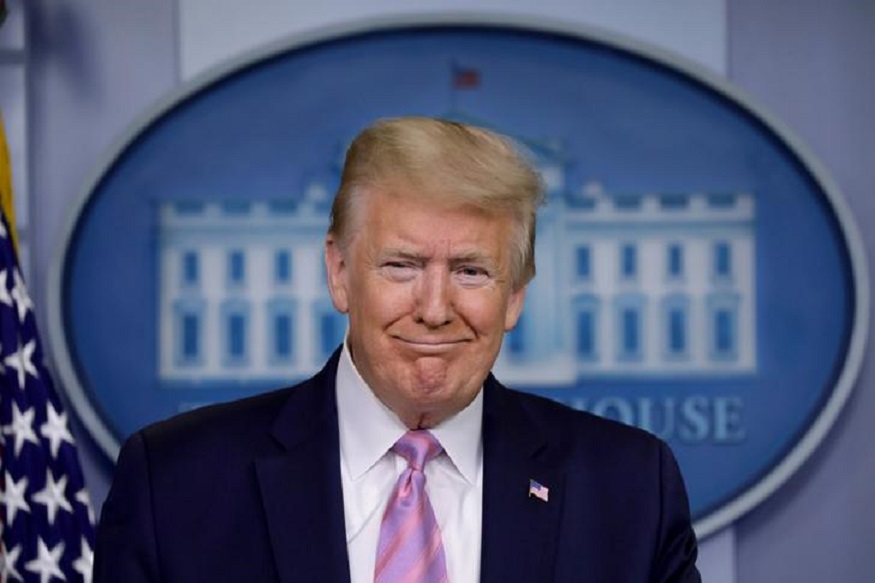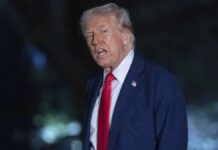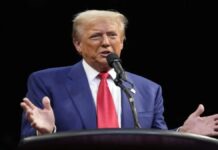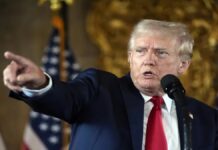
President Donald Trump gave governors a road map Thursday for recovering from the economic pain of the coronavirus pandemic, laying out “a phased and deliberate approach” to restoring normal activity in places that have strong testing and are seeing a decrease in COVID-19 cases.
“We’re starting our life again,” Trump said during his daily press briefing. “We’re starting rejuvenation of our economy again.”
He added, “This may be a gradual process.”
The new guidelines are aimed toward easing restrictions in areas with low transmission of the coronavirus, while holding the road in harder-hit locations. they create clear that the return to normalcy are going to be a far longer process than Trump initially envisioned, with federal officials warning that some social distancing measures may have to stay in situ through the top of the year to stop a replacement outbreak. and that they largely reinforce the plans already under development by governors, who have the first responsibility for public health in their states.
“You’re getting to call your own shots,” Trump told the governors Thursday afternoon during a call , consistent with an sound recording obtained by The Associated Press. “We’re getting to be standing alongside of you.”
Places with declining infections and powerful testing would begin a three-phase gradual reopening of companies and schools.
In phase one, as an example , the plan recommends strict social distancing for all people publicly . Gatherings larger than 10 people are to be avoided and nonessential travel is discouraged.
In phase two, people are encouraged to maximise social distancing where possible and limit gatherings to no quite 50 people unless precautionary measures are taken. Travel could resume.
Phase three envisions a return to normalcy for many Americans, with attention on identification and isolation of any new infections.
The Associated Press obtained a replica of the rules before their public release.
Governors of both parties made clear they’re going to move at their own pace.
Delaware Gov. John Carney, a Democrat, said the rules “seem to form sense.”
“We’re days, maybe weeks faraway from the start then you’ve got to possess 14 days of declining cases, of declining symptoms and hospital capacity that exists just in case you’ve got a rebound,” he said.
West Virginia Gov. Jim Justice, a Trump ally, cautiously floated the thought of reopening parts of the state, but said testing capacity and get in touch with tracing would wish to be considerably ramped up before restrictions might be safely lifted.
“All would be forgotten very quickly if we moved into a stage quicker than we should always , then we got into a situation where we had people dying like flies,” Justice told reporters.
At earliest, the rules suggest, some parts of the country could see a resumption in normal commerce and social gatherings after a month of evaluating whether easing abreast of restrictions has led to a resurgence in virus cases. In other parts of the country, or if virus cases devour , it might be substantially longer.
In briefing the governors on the plan, Trump said they were getting to be liable for deciding when it’s safe to lift restrictions in their states. Just days before, he had drawn swift pushback for claiming he had absolutely the authority to work out how and when states reopen.
“We have a really sizable amount of states that want to urge going and they’re in excellent shape,” Trump said. “That’s good with us, frankly.”
The guidelines also include general recommendations to businesses as they plan for potential reopenings, suggesting temperature-taking, rapid COVID-19 testing and widespread disinfection efforts in workplaces.
Those most vulnerable to the respiratory illness are advised to stay sheltered in situ until their area enters the ultimate phase — and even then are encouraged to require precautions to avoid close contact with people .
Governors, for his or her part, are moving ahead with their own plans for a way to securely revive normal activity. Seven Midwestern governors announced Thursday they’re going to coordinate on reopening their economies. Similar pacts were announced earlier within the week within the West and Northeast.
Two in three Americans expressed concerns that restrictions meant to slow the spread of the virus would be eased too quickly, consistent with a Pew research facility survey released Thursday.
Trump also held conference calls Thursday with lawmakers he named to a replacement congressional advisory task force on reviving the economy. The economic costs were clear in new federal data showing that a minimum of 22 million Americans are thrown out of labor within the last month. But the legislators repeatedly urged the president to not sacrifice public health by moving too quickly.
“My highest priority on this task force are going to be to make sure the federal government’s efforts to reopen our economy are bipartisan, data-driven, and supported the expertise of public health professionals,” said Democratic Sen. Mark Warner of Virginia.
The federal envisions a gradual recovery from the virus, during which disruptive mitigation measures could also be needed in some places a minimum of until a vaccine is out there — a milestone unlikely to be reached until sometime next year.
“It’s not getting to immediately be a situation where we’ve stadiums filled with people,” said Housing and concrete Development Secretary Ben Carson on Thursday. “We’re Americans. we’ll adapt,” he added.
Trump on Thursday claimed the U.S. has “built the foremost advanced and robust testing anywhere within the world.” But even people on the brink of him warned more would be necessary.
“We are battling testing at an outsized scale,” South Carolina Sen. Lindsey Graham told ABC’s “The View.” “You really can’t return to figure until we’ve more tests.”
But a number of Trump’s conservative allies, like economist Stephen Moore, have encouraged him to act swiftly, warning of “a mini Great Depression if we keep the economy pack up .”
“That may be a catastrophic outcome for our country. Period,” Moore said he advised the president. “We can’t have 30 million people during this country unemployed or you’re getting to have social chaos.”
A big laboratory for Trump’s road map might be Texas, where Republican Gov. Greg Abbott, who has stuck on the brink of federal guidance throughout the crisis, will lay out his reopening plan Friday. Abbott has said the method are going to be gradual, but he’s facing pressure from conservative lawmakers to urge Texas back to figure .











